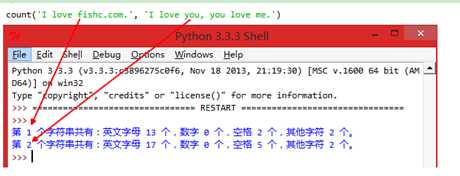标签:trace 形式 作用域 cti global += 内容 print 一句话
解释:函数与过程
函数(Function):有返回值
过程(procedure):是简单、特殊并没有返回值的
1.函数
Python是只有函数没有过程的
>>> def hell(): print(‘Hi好‘) #hell()函数没有返回值 >>> temp = hell() #hell()赋值给temp,hell()函数没有返回值,所以temp没有返回值
Hi好
>>> temp
>>> print(temp)
None #没有返回值,也会返回none,所以都是有返回值
>>> type(temp)
<class ‘NoneType‘>
>>>
以上说明Python只有函数(都有返回值)
2.函数的返回值
可以是多个值,不同类型
>>> def test1(): return [1,2,3.14,‘hello‘,[4,5,6]] >>> test1() [1, 2, 3.14, ‘hello‘, [4, 5, 6]] >>>
>>> def test1(): return 1,2,3.14,‘hello‘,[4,5,6] >>> test1() (1, 2, 3.14, ‘hello‘, [4, 5, 6]) >>>
3.函数变量的作用域
全局变量 、局部变量
def discounts(price,rate): final_price = price * rate return final_price rate = float(input(‘请输入折扣率:‘)) old_price = float(input(‘请输入原价是:‘)) new_price = discounts(old_price,rate) print(‘打折后的价格是:‘,new_price)
结果:
============ RESTART: D:/cj/python/Python script/19/jububianliang.py =========== 请输入折扣率:0.8 请输入原价是:188 打折后的价格是: 150.4 >>>
局部变量
只能在其函数内部生效,出了函数的范围,是无效的,例如:
def discounts(price,rate): final_price = price * rate return final_price rate = float(input(‘请输入折扣率:‘)) old_price = float(input(‘请输入原价是:‘)) new_price = discounts(old_price,rate) print(‘打折后的价格是:‘,new_price) print(‘这里试图打印局部变量:‘,final_price)
结果:
============ RESTART: D:/cj/python/Python script/19/jububianliang.py =========== 请输入折扣率:0.8 请输入原价是:100 打折后的价格是: 80.0 Traceback (most recent call last): File "D:/cj/python/Python script/19/jububianliang.py", line 9, in <module> print(‘这里试图打印局部变量:‘,final_price) NameError: name ‘final_price‘ is not defined >>>
总结:在函数里面定义的参数,如上面的final_price都称之为局部变量,出了这个函数,这些变量是无效的。
全局变量
函数外面定义的变量叫做全局变量,作用域是整个代码段。
例如:在函数内部读取全局变量
def discounts(price,rate): final_price = price * rate print(‘这里试图打印全部变量old_price,‘,old_price) return final_price rate = float(input(‘请输入折扣率:‘)) old_price = float(input(‘请输入原价是:‘)) new_price = discounts(old_price,rate) print(‘打折后的价格是:‘,new_price)
结果:
============ RESTART: D:/cj/python/Python script/19/jububianliang.py =========== 请输入折扣率:0.8 请输入原价是:100 这里试图打印全部变量old_price, 100.0 打折后的价格是: 80.0 >>>
试图在函数中修改全局变量,Python会在函数内创建一个跟全局变量名字一样的局部变量,名字是一模一样。
def discounts(price,rate): final_price = price * rate old_price = 50 print(‘修改后的old_price的价格1是::‘,old_price) return final_price rate = float(input(‘请输入折扣率:‘)) old_price = float(input(‘请输入原价是:‘)) new_price = discounts(old_price,rate) print(‘修改后的old_price的价格2是::‘,old_price) print(‘打折后的价格是:‘,new_price)
结果:
============ RESTART: D:/cj/python/Python script/19/jububianliang.py =========== 请输入折扣率:0.8 请输入原价是:100 修改后的old_price的价格1是:: 50 修改后的old_price的价格2是:: 100.0 打折后的价格是: 80.0 >>>
总结:不要在函数中修改全局变量,可以在函数中调用全部变量。(实在要改,后面学习方法)
课后习题:
0.下边程序会输入什么?
>>> def next(): print(‘我在next()函数里‘) pre() >>> def pre(): print(‘我在pre()函数里面‘)
>>> next() 我在next()函数里 我在pre()函数里面 >>>
1.请问一下这个函数有返回值吗?
>>> def Fun(): print(‘hello world‘)
>>> print(Fun()) hello world None >>>
>>> temp = Fun()
hello world
>>> print(temp)
None
>>>
有返回值,如果函数没有return语句也是有返回值的,返回的是一个None对象,所以我们说python所有的函数都有返回值
2.请问Python的return语句可以返回多个不同类型的值吗?
可以,默认用逗号隔开,是以元组的形式返回,也可以用列表包含起来返回。
>>> def test1(): return 1,2,3.14,‘hello‘,[4,5,6] >>> test1() (1, 2, 3.14, ‘hello‘, [4, 5, 6]) >>>
3.目测一下程序会打印什么内容?
def fun(var): var = 1314 print(var,end = ‘‘) var = 520 fun(var) print(var)
结果:1314520 (var的赋值操作只在函数内有效。)
4.目测一下程序会打印什么内容?
var = ‘Hi‘ def fun1(): global var var = ‘ Baby ‘ return fun2(var) def fun2(var): var+= ‘I love you‘ fun3(var) return var def fun3(var): var = ‘ 小甲鱼‘ print(fun1())
结果:Baby I love you
0.编写一个函数,判断传入的字符串参数是否为‘回文联’(回文联即用回文形式携程的对联,既可顺读,也可倒读。例如:上海自来水来自海上)
def palindrome(string): length = len(string) last = length-1 length //= 2 flag = 1 for each in range(length): if string[each] != string[last]: flag = 0 last -= 1 if flag == 1: return 1 else: return 0 string = input(‘请输入一句话:‘) if palindrome(string) == 1: print(‘是回文联‘) else: print("不是回文联")
1. 编写一个函数,分别统计出传入字符串参数(可能不只一个参数)的英文字母、空格、数字和其它字符的个数。

def type_count(*string): length=len(string) for i in range(length): letters=0 digit=0 space=0 others=0 for each in string[i]: if each.isalpha(): letters+=1 elif each.isdigit(): digit+=1 elif each == ‘‘: space+=1 else: others+=1 print(‘第%d个字符串有%d个字母,%d个数字,%d个空格,%d个其他字符‘ %(i+1 , letters, digit , space, others)) type_count(‘I love fishc.com.‘,‘i love you, you love me.‘)
第019讲:函数 我的地盘听我的--函数变量的作用域(课后测试题及答案 )
标签:trace 形式 作用域 cti global += 内容 print 一句话
原文地址:https://www.cnblogs.com/ananmy/p/12288698.html